Instruments used in general medicine
Instruments used in general medicine and clinics (i.e. internal medicine and pediatrics) are as follows:[1][2]
Instrument list
This list is incomplete; you can help by expanding it.
| Instrument | Uses |
|---|---|
| Bandage | to cover and protect areas of the body, such as a recent injury |
| Bedpan | for patients who are unconscious or too weak to sit up or walk to the toilet to defecate |
| Cannula | to create a permanent pathway to a vein (or artery) for the purpose of repeated injections or infusion of intravenous fluids |
| Cardioverter / Defibrillator | to correct arrhythmias of the heart or to start up a heart that is not beating |
| Catheter | to drain and collect urine directly from the bladder (primary use); also to act as a makeshift oxygen tube, etc. |
| Dialyser | to remove toxic materials from the blood that are generally removed by the kidneys; used in case of renal failure |
| Electrocardiograph machine | to record the electrical activity of the heart over a period of time |
| Enema equipment | to passively evacuate the rectum of faeces |
| Endoscope | to look inside the gastrointestinal tract, used mainly in surgery or by surgical consultants |
| Gas cylinder | as a supply of oxygen, nitrous oxide, carbon dioxide, etc. |
| Gauze sponge | to absorb blood and other fluids as well as clean wounds |
| Hypodermic needle / Syringe | for injections and aspiration of blood or fluid from the body |
| Infection control equipment | as in gloves, gowns, bonnets, shoe covers, face shields, goggles, and surgical masks for preventing nosocomial or healthcare-associated infection |
| Instrument sterilizer | to sterilize instruments in absence of an autoclave |
| Kidney dish | as a tray for instruments, gauze, tissue, etc. |
| Measuring tape | for length, height, and girth measurements |
| Medical halogen penlight | to see into the eye, natural orifices, etc. and to test for pupillary light reflex, etc. |
| Nasogastric tube | for nasogastric suction or the introduction of food or drugs into the body |
| Nebulizer | to produce aerosols of drugs to be administered by respiratory route |
| Ophthalmoscope | to look at the retina |
| Otoscope | to look into the external ear cavity |
| Oxygen mask and tubes | to deliver gases to the mouth/nostrils to assist in oxygen intake or to administer aerosolized or gaseous drugs |
| Pipette or dropper | to measure out doses of liquid, specially in children |
| Proctoscope | to look inside the anal canal and lower part of the rectum |
| Reflex hammer | to test motor reflexs of the body |
| Sphygmomanometer | to measure the patient's blood pressure |
| Stethoscope | to hear sounds from movements within the body like heart beats, intestinal movement, breath sounds, etc. |
| Suction device | to suck up blood or secretions |
| Thermometer | to record body temperature |
| Tongue depressor | for use in oral examination |
| Transfusion kit | to transfuse blood and blood products |
| Tuning fork | to test for deafness and to categorize it |
| Ventilator | to assist or carry out the mechanical act of inspiration and expiration so the non-respiring patient can do so; a common component of "life support" |
| Watch / Stopwatch | for recording rates like heart rate, respiratory rate, etc.; for certain hearing tests |
| Weighing scale | to measure weight |
Image gallery
-

Bandage
-

Bedpan
-

Blood infusion set
-

Cannula, intraveneous (separated)
-

Catheter, Foley
-
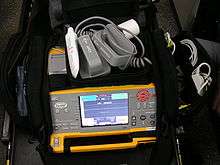
Defibrillator
-

Dialyser, hemodialysis
-

Enema bulb
-

Enema set
-

Endoscope
-

Face shield
-
Gas cylinder, oxygen
-
Gauze sponges
-
Instrument sterilizer
-

Kidney dish
-
Medical halogen penlight
-
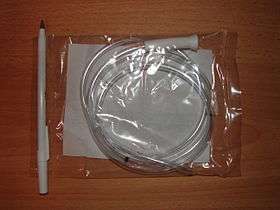
Nasogastric tube, Levin
-

Nebulizer
-
Ophthalmoscope
-

Reflex hammer
-
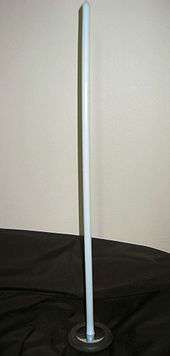
Reflex hammer, queen square
-
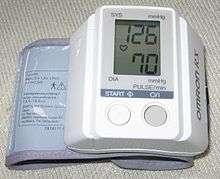
Sphygmomanometer, electronic
-

Stethoscope
-
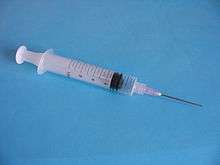
Syringe and needle
-

Thermometers, mercury
-

Tongue depressors
-

Tuning fork
-
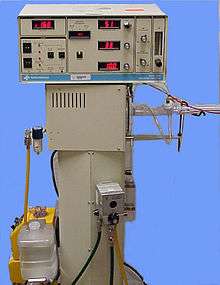
Ventilator, high-frequency
-

Weighing scale
-
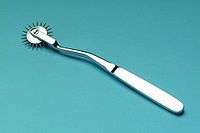
Wartenbergwheel
References
This article is issued from Wikipedia - version of the 8/1/2016. The text is available under the Creative Commons Attribution/Share Alike but additional terms may apply for the media files.